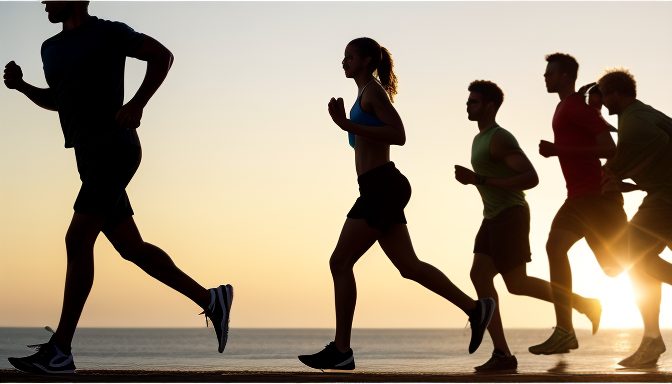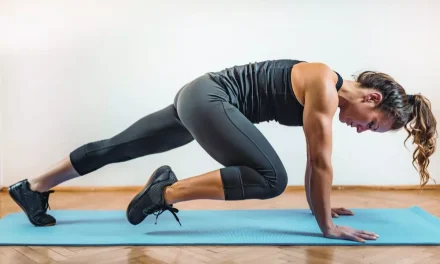In this article:

How to be physically active and healthy at any age
Physical activity is one of the key factors for a long and healthy life.
At age-healthy, we don’t just want you to live longer, we want you to live better.
We want you to be a healthy, independent and fulfilled person to the last day of your life.
But what does it mean to be physically active?
And how can you do it in a way that suits your needs and preferences? Here are some tips and insights to help you.
Physical activity is not working out
Many people think that physical activity means going to the gym, lifting weights, running on a treadmill or doing some other form of structured exercise. While these are valid ways of being active, they are not the only ones.
In fact, physical activity can be any movement that makes your muscles work and requires energy.
It can be as simple as walking, cycling, taking the stairs, playing with your children, carrying groceries or gardening. Or even just get up from the sofa and do some stretching, as long as your heartbeat goes up a little.
Be creative, invent new ways of being active and enjoy your activity time!
These are all examples of what we call “exercise snacks”, short bursts of activity that you can do throughout the day.
Research has shown that these exercise snacks can significantly lower your risk of dying from any cause, as well as improve your mood, energy and brain function. In a 2021 study, obese people were asked to interrupt their sitting every 30 minutes and perform 3 minutes oflow-to-moderate-intensity physical activity. Their fasting glucose levels significantly improved, and the improvements increased together with the intensity of the exercises. In fact, a single bout of exercise enhances whole body insulin sensitivity (your ability to utilize the energy in excess) for up to 48 hours.
Enjoy what you are doing
Another important aspect of physical activity is enjoyment. When you enjoy what you are doing, you are more likely to stick with it and reap the benefits. Moreover, enjoyment can enhance your learning and memory. How? Well, your brain is constantly processing the information that you receive from your senses and experiences. However, not all of this information is stored in your long-term memory.
Your brain decides what to keep and what to discard based on your emotions.
If you have positive emotions associated with an activity, such as fun, satisfaction or curiosity, your brain is more likely to remember it and consolidate it during sleep. This is why learning new skills, such as playing an instrument, speaking a language or dancing, can boost your brain health and prevent cognitive decline. If you do no continuosly learn new thing or consolidate what you already have, by for example exercising new parts of the body, new movements, trying to improve your coordination or, for example, trying to do complicating tasks with your weak hand, like brushing your teeth, your cognitivie functinality will eventually decline.
Socialize
Working out or simple physical activity are a great opportunity to socialize.
Wether we are walking to the office, playing tennis with friends, or just playing with your family, doing sport and any sort of activity together will have incredible benefits.
Socializing is a natural way to reduce stress and maintain a sense of purpose in our lives. As social beings, we find happiness in sharing our experiences, which helps to naturally lower our cortisol levels (the stress hormone), and activate our vagal nerve (our unconscious way of winding down and enter the recovery process which usually happens at night). By activating our vagal nerve, known for inducing relaxation, we are already kickstarting our recovery from exercising while we are still in the midst of it.
Work out every day, but do it well
Besides being physically active throughout the day, it is also beneficial to work out every day, but in a smart way.
Working out encompasses various aspects of physical fitness – flexibility, functionality, strength, and stamina, all of which require a dedicated effort.
Embracing these challenges is essential for achieving optimal results in your fitness journey.
-
Flexibility
Flexibility helps you maintain your range of motion and prevent injuries. Research has shown that stretching can improve flexibility and the joint mobility. Better flexibility may also improve your performance in physical activities, decrease inflammation, modulate pain and speed up recovery. Furthermore, flexibility may have positive effects on certain diseases, such as diabetes and arthritis. Therefore, stretching regularly is important for your health and well-being.
-
Functionality
Functionality enables you to effortlessly and efficiently carry out everyday tasks. It goes beyond merely moving your leg muscles—it involves coordinating them to accomplish specific actions like balancing on one foot with ease. But it also involves the ability to put yourself into space and react quickly, for example by throwing a ball on the wall and catching it again when it comes back, playing table tennis, or simply playing games with your children or nephews. If we do not train daily these abilities, we will quickly lose them. Keep trying them in your daily life: try lacing your shows standin on one leg, walk backwards, or side-to-side running: your brain will thank you for that.
-
Strength
Strength training is not only good for building muscles, but also for improving general health and functional longevity. According to several studies, people who do strength training regularly have a lower risk of dying prematurely from any cause, compared to those who don’t . Strength training can also help prevent chronic diseases, such as cardiovascular disease, diabetes, and osteoporosis . The recommended amount of strength training is 30 to 60 minutes per week, which can be combined with aerobic exercise for optimal results .
-
Stamina
Endurance training is a type of exercise that improves the ability of our muscles to use oxygen and produce energy. This can have positive effects on our general health and functional longevity, as it can prevent or delay many chronic diseases and age-related declines. One of the key factors that determine our endurance capacity, or stamina, is the function of our mitochondria, which are the organelles that generate most of the energy in our cells. Endurance training can increase the number and efficiency of mitochondria in our muscles, which can enhance our performance and health . Some researches have found that you can double your mitochondrial activity with 5 weeks of endurance training, but you can also lose most of these gains in just 2 weeks of inactivity. This is why studies have shown that hip injuries in people over 70 are correlated to a 90% possibility of death in 1 year: after a hip injury you have to stay in bed for weeks, and your metabolism will be depleted.
While studies have shown that moderate-intensity training can improve mitochondrial fitness, excessive or prolonged training can also impair it . Therefore, it is important to balance the amount and intensity of endurance training to optimize our mitochondrial function and health benefits. You need to find the right balance between intensity, volumes, frequency, and recovery and rest times. This is no easy task. You should refer to specialists that know exaclty how to create the perfect workout plan based on your fitness level, taste, and targets.
Adapt your diet and lifestyle to your workout routine
Finally, physical activity is not an isolated factor in your health. It intertwines with other aspects of your diet and lifestyle, influencing your appetite, metabolism, and sleep quality. It is essential to be mindful of your dietary choices and meal timing to maintain a balanced diet that adequately fuels your muscles and aids in recovery. Studies have demonstrated that consistently working out at the same time, such as in the morning, enables your body to adapt and prepare for the daily exertion. Additionally, it is advisable to avoid eating too close to bedtime or too late at night, as this can disrupt your sleep quality and hormone balance.
Conclusion
Physical activity is an invaluable resource for enhancing your overall well-being and health, no matter your age.
Our mission at age-healthy is to assist you in discovering the most suitable and tailored approach to staying physically active based on your unique preferences and needs.
We understand that transforming your entire lifestyle overnight to become a fitness fanatic is unnecessary.
Instead, we are here to provide guidance and support as you gradually incorporate sustainable changes that progressively boost your fitness levels. It’s worth noting that many individuals abandon their gym routines within three months, a situation we aim to prevent. Our objective is to collaborate closely with you in order to determine:
- Physical activities that genuinely bring you joy;
- Activities that align with your capabilities and limitations;
- Activities that will yield the greatest benefits for you.
Whether you prefer focused workouts or integrating physical movement into your daily routine, whether you derive satisfaction from acquiring new skills or prefer sticking to familiar ones, or whether you desire more structured guidance or the freedom to explore, we have precisely what you need to cater to your individual requirements.
Get in touch with us today and allow us the opportunity to assist you in reaching your goals.
Sources:
- Schwingshackl L, Missbach B, Dias S, König J, Hoffmann G. Impact of different training modalities on glycaemic control and blood lipids in patients with type 2 diabetes: a systematic review and network meta-analysis. Diabetologia. 2014 Sep;57(9):1789-97. doi: 10.1007/s00125-014-3303-z. Epub 2014 Jul 5. PMID: 24996616.
-
Jonathon A. B. Smith, Mladen Savikj, Parneet Sethi, Simon Platt, Brendan M. Gabriel, John A. Hawley, David Dunstan, Anna Krook, Juleen R. Zierath, and Erik Näslund Three weeks of interrupting sitting lowers fasting glucose and glycemic variability, but not glucose tolerance, in free-living women and men with obesity American Journal of Physiology-Endocrinology and Metabolism 2021 321:2, E203-E216
- Haeger, R.M., Rassier, D.E. Force enhancement after stretch of isolated myofibrils is increased by sarcomere length non-uniformities. Sci Rep 10, 21590 (2020). https://doi.org/10.1038/s41598-020-78457-1
- William D Bandy, Jean M Irion, Michelle Briggler, The Effect of Time and Frequency of Static Stretching on Flexibility of the Hamstring Muscles, Physical Therapy, Volume 77, Issue 10, 1 October 1997, Pages 1090–1096, https://doi.org/10.1093/ptj/77.10.1090




